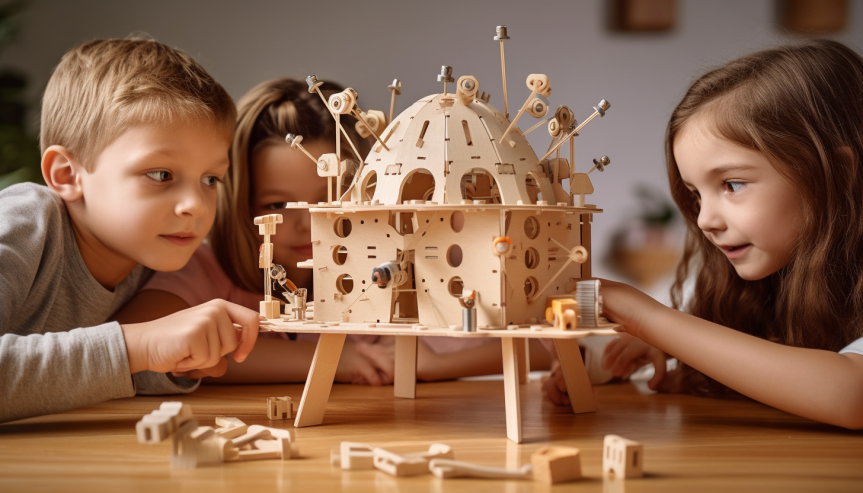Exploring Physics for Kids: Fun Lessons & Quizzes to Learn
We will embark on a thrilling exploration of physics for kids, covering a variety of fun lessons, activities, and quizzes that will spark curiosity and encourage learning.

Physics, the fascinating study of the natural world and its principles, may at first seem daunting and complex for kids. However, with the right approach and engaging activities, it can become an exciting journey of discovery for young minds. Dive into the wonders of physics and explore the captivating ways it can be made fun and engaging for kids, from hands-on experiments to games and quizzes.
In this blog post, we will embark on a thrilling exploration of physics for kids, covering a variety of fun lessons, activities, and quizzes that will spark curiosity and encourage learning. Unravel the mysteries of forces and motion, delve into the world of light and shadows, experiment with gravity, and more. So buckle up and get ready to ignite your child’s passion for physics!
Key Takeaways
- Explore the exciting world of physics with engaging activities and experiments.
- Discover forces and motion, magnetism, buoyancy, light & shadows as well as simple machines.
- Reinforce understanding through quizzes & games to develop problem solving skills & creativity.
Understanding Physics for Kids

Physics is a branch of science that studies matter, its motion and its connection with energy and forces. This branch of science delves into the physical properties of our universe and the behaviour of various forms of matter. It governs the natural world, and physicists study these principles to enhance our knowledge of the universe. From the motion of objects to the behavior of light, physics studies unravel the mysteries of our world and have paved the way for numerous technological advancements.
Throughout history, renowned physicists such as Sir Isaac Newton and Professor Albert Einstein have made groundbreaking discoveries that revolutionized our understanding of the universe. As we introduce our children to the fascinating world of physics, we can draw inspiration from these legendary minds and their remarkable contributions to the field.
The Science Behind Physics
Physics is the scientific discipline that focuses on matter and energy and their interactions, with the ultimate goal of understanding the natural world. The field of physics is highly comprehensive, including different areas like:
- electricity
- astronomy
- motion
- waves
- sound
- light
Each branch has its own unique characteristics that contribute to the overall science of physics. Fostering exploration of these various branches can help young minds build a solid physics foundation while cultivating a lifelong appreciation for the sciences.
The principles of physics govern everything from the smallest atoms to the vast cosmos, thereby illustrating the interconnectedness of the universe. Studying physics enables children to grasp the fundamental nature of their surroundings, sparking curiosity to uncover deeper mysteries of our existence.
Famous Physicists
Throughout history, there have been many physicists who have made groundbreaking contributions to the field. Sir Isaac Newton, for instance, is widely acknowledged for his development of the laws of motion and universal gravitation. Another renowned physicist, Professor Albert Einstein, revolutionized our comprehension of space and time with his theory of relativity.
Additionally, other called physicists, such as:
- Galileo Galilei
- Marie Curie
- Niels Bohr
- Richard Feynman
We have significantly expanded our understanding of the universe. Introducing children to the lives and accomplishments of these extraordinary scientists can inspire them to venture into their own explorations within the captivating realm of physics.
Fun Ways to Teach Physics to Kids

For captivating young minds and fostering a love for learning, presenting physics in an engaging and enjoyable manner is key. Incorporating hands-on activities and experiments can bring physics to life, transforming it into an exciting adventure for children.
In the following sections, we will introduce a variety of fun activities and experiments that will help children delve into the captivating world of physics. From experimenting with gravity to discovering forces and motion, and investigating light and shadows, these activities will not only enhance their understanding of physics principles, but also ignite their passion for scientific exploration.
Experiment with Gravity
Gravity is the force that attracts two bodies towards one another. To help children grasp the concept of gravity, simple experiments can be conducted, such as dropping heavy objects from different heights and observing their fall. Watching objects fall allows children to witness firsthand gravity’s impact on objects, regardless of their shape, size, or mass.
Another engaging activity is to roll objects down an incline and note their speed as they fall faster. This allows children to observe how gravity impacts the motion of objects as they travel downhill. Through these hands-on experiments, young learners can gain a better understanding of gravity and its omnipresent influence on our world.
Discover Forces and Motion

Forces and motion are fundamental concepts in physics, with forces defined as pushes or pulls that can cause objects to move, stop, or change direction, and motion referring to the movement of objects. To help children discover the fascinating world of forces and motion, they can engage in activities such as playing with toy cars and balls.
Experimenting with gravity, as mentioned earlier, is another excellent way for children to explore forces and motion. Additionally, children can explore forces and motion by:
- Investigating light and shadows
- Exploring magnetism
- Learning about buoyancy
- Learning about simple machines
These activities can provide valuable insights into the relevant principles governing forces and motion, as students search for a deeper understanding of these concepts.
Through these exciting activities, children can develop a solid foundation in physics and foster a love for learning.
Investigate Light and Shadows
Light is a form of energy that allows us to perceive objects, and shadows are created when an object obstructs the path of light. To investigate light and shadows, children can engage in shadow puppetry, which is an entertaining way to learn about the science behind light and shadows.
Another intriguing activity involves observing the changes in shadows throughout the day. By noting the variations in shadow length as the sun moves across the sky, children can learn about the relationship between the position of the sun and the length of shadows.
These hands-on activities will not only help children develop a deeper understanding of light and shadows, but also provide an enjoyable and memorable learning experience.
Hands-on Physics Activities for Children

Hands-on physics activities are an effective way to engage children in the exploration of various physics concepts. These activities enable children to:
- Investigate and comprehend physics principles in an entertaining and stimulating manner
- Foster the development of problem-solving abilities
- Enhance critical thinking skills
- Encourage creativity
The subsequent sections detail specific hands-on activities that can aid children in exploring concepts like magnetism, buoyancy, and simple machines. These engaging activities will not only enhance their understanding of physics, but also encourage them to think critically and creatively as they navigate the fascinating world of science.
Exploring Magnetism
Magnetism is the force exerted by magnets when they attract or repel one another, which is caused by the motion of electric charges. To help children explore the captivating world of magnetism, they can engage in simple yet intriguing activities such as searching for items in the house that possess magnetic properties or constructing a compass.
By experimenting with magnets, children can gain a better understanding of the properties associated with magnetism, such as the existence of two poles (north and south) and the ability to generate a magnetic field. These hands-on activities can enable young learners to gain valuable insights into the intriguing world of magnetism and its daily life applications.
Understanding Buoyancy
Buoyancy, commonly referred to as upthrust, is an upward force exerted by a fluid that counters the weight of a partially or completely submerged object. To help children understand buoyancy, they can engage in activities such as floating and sinking objects in water.
By observing which objects float and which ones sink, children can learn that objects with lower density compared to water tend to float, while those with higher density sink. These hands-on activities will not only help children comprehend the concept of buoyancy, but also instill a sense of wonder and curiosity as they explore the science behind the everyday phenomenon of floating and sinking.
Learning About Simple Machines
Simple machines are devices with few or no moving parts that are utilized to alter motion and force in order to carry out work. The six classical simple machines include:
- Lever
- Wheel and axle
- Pulley
- Inclined plane
- Wedge
- Screw
By learning about these simple machines and their functions, children can develop a deeper understanding of how they make our lives easier.
Everyday objects can serve as excellent examples to help children learn about simple machines. For instance, the following objects are all simple machines found in our daily lives:
- Hammer (lever)
- Doorknob (wheel and axle)
- Flagpole (pulley)
- Ramp (inclined plane)
- Knife (wedge)
- Screwdriver (screw)
Through the exploration of simple machines, children can gain valuable insights into the fundamental principles of physics and their applications in the world around them.
Engaging Your Child's Curious Mind

Ensuring a meaningful learning experience involves engaging your child’s curious mind and encouraging exploration across varied physics-related topics. Introducing diverse activities and experiments, tailored to their interests, not only deepens their understanding of physics principles, but also nurtures a love for scientific exploration.
In the following sections, we will delve into specific topics such as astronomy and the universe, and electricity and energy, providing engaging activities and discussions that can be easily incorporated into your child’s learning journey. These activities will not only ignite their curiosity, but also empower them to think critically and creatively as they uncover the wonders of physics.
Astronomy and the Universe
Astronomy, the scientific study of celestial objects and their properties, offers an exciting gateway for children to explore the mysteries of the universe. Introducing astronomy to kids can be as simple as engaging in stargazing or learning about the various planets within our solar system and their attributes.
By uncovering the chronology of space exploration and diverse spacecrafts that have been deployed to investigate the planets, including Earth, children can gain valuable insights into the vastness of the universe and our place within it. Encouraging an interest in astronomy and the universe not only broadens their horizons, but also instills a sense of wonder and fascination with the cosmos.
Electricity and Energy
Electricity and energy are essential concepts in physics, with electricity referring to the flow of electrons through a conductor, and energy being the capacity to perform work. To help children learn about these concepts, simple experiments and discussions can be conducted, such as constructing circuits, investigating magnetism, and experimenting with light and shadows.
Through these engaging activities, children can develop a deeper understanding of electricity and energy, as well as their applications in our everyday lives. Furthermore, these hands-on experiences will not only foster a love for learning, but also empower children to think critically and creatively as they uncover the fascinating world of physics.
Physics Quizzes and Games for Kids
Quizzes and games can significantly contribute to making physics learning fun and engaging for kids. By incorporating these entertaining activities into their learning journey, children can:
- Reinforce their understanding of physics concepts
- Develop problem-solving skills
- Enhance critical thinking abilities
- Foster creativity
Some examples of physics quizzes and games for children include:
- Physics Trivia Quiz Games
- Physics Quiz on Science Kids
- Glorious Physics for Kids Quiz on Fun Trivia
- Physics games on Common Sense Education, Quiz Beez, and iGameMom
By engaging in these quizzes and games, children can enhance their learning experience and foster a love for physics that will last a lifetime.
Summary
In conclusion, making physics fun and engaging for kids is crucial to spark their curiosity and encourage learning. By exploring various hands-on activities and experiments, introducing captivating topics such as astronomy and the universe, and incorporating quizzes and games, children can develop a solid foundation in physics and cultivate a lifelong appreciation for the sciences.
As parents and educators, it is our responsibility to ignite the passion for learning in our children and empower them to explore the fascinating world of physics. By doing so, we not only broaden their horizons, but also inspire them to pursue their own path of discovery and uncover the wonders of the universe.
Frequently Asked Questions
How do you explain physics to a kid?
Physics is the study of matter and its motion through space and time, as well as how it interacts with energy and forces. It explains gravity and the way things move, along with the behavior and movement of energy such as heat, light and electricity.
It is a powerful subject that can help kids unlock many mysteries of the universe.
What is the basics of physics?
Physics is a natural science that studies matter, its motion and behaviour through space and time, along with related concepts such as energy and force. It explores the physical laws of energy, matter, and nature’s forces, and uses principles such as Newton’s Laws of Motion, gravity and theory to understand how the universe behaves.
Why should kids learn physics?
Learning physics provides an essential foundation to understanding the universe around us, as well as strengthening key skills in problem solving, quantitative reasoning, and creativity.
It also increases knowledge of modern technologies and provides important practice in mathematics that is beneficial for SAT tests.
What are some engaging methods to teach physics to children?
Engaging methods to teach physics to children may include hands-on activities and experiments, simple experiments, physics games and activities, virtual resources and simulations, and interactive ball games.
What is the difference between electricity and energy?
Electricity is a form of energy, where energy refers to the potential for work to be done.
Electricity, on the other hand, specifically references the passage of electrons through conductors.

